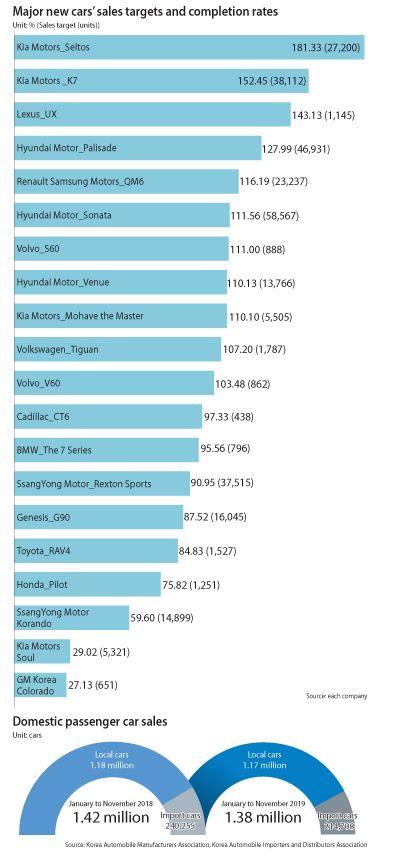SUVs are kings of the road as sedans pull over

As of the end of November, a total of 1.39 million cars were sold this year, 1.17 million by local automakers and 214,708 as imports. The total number for 2019 is expected to be lower than 1.56 million units in total sales posted in 2018, following the global trend of declining automobile sales.
Despite the sales decline, domestic and foreign auto brands still released a similar number of new cars compared with last year, including face-lifted models, to target local consumers.
Between November last year and October this year, 100 new vehicles were introduced in Korea, and of the 20 models that revealed sales targets, more than half, or 11 of them, reached their goals. They enjoyed the so-called “new car” effect and broke their sales goals within the first year of their releases.
“Most of the cars start collecting demand with pre-sales and more before officially launching, so the new car effect is on for around six months after release,” said Kim Pil-soo, an automotive engineering professor at Daelim University.

According to the Korea Automobile Manufacturers Association, 44.2 percent of all vehicles sold in the first half were SUVs, coming close to sedans, at 51.4 percent.
As the general popularity of SUVs has risen, a wide range of shapes and forms are on offer. While midsize SUVs achieved record sales last year, this year served as a turning point for small-size and large-size models as well.
The proportion of all SUV sales that were midsize SUVs between January and October dropped to 35 percent from 43.2 percent during the same period last year. The proportion for large-size SUVs went from 24.8 percent to 25.6 percent, and the rate for small SUVs rose from 32 percent to 38.9 percent.
Hyundai Motor’s Palisade led the large-size segment, while Kia Motors’ Seltos led the small-size market. Hyundai Motor revised its yearly sales target from 25,000 to 40,000 for the Palisade after achieving unexpected success.
Kia Motors, which recorded the most sales compared to goals, sold 27,200 units of the Seltos in the first four months following release, even though the automaker set 3,000 as the monthly target for the small-size SUV. Following the popularity, Kia Motors revised the sales target to 5,000 units per month.
Models like those helped Hyundai Motor Group retain a 67.7 percent market share in the local auto market this year, up 2.5 percentage points from 65.2 percent last year. The largest automaker group in Korea saw its dominance continue in the country as other local automakers and importers struggled.
Of the 11 new cars that hit their yearly goals, six of them were from Hyundai Motor and Kia Motors. The two sibling automakers could enjoy relative success in the local market as German and Japanese automakers struggled on the Korean front.
Between January and November this year, Hyundai Motor and Kia Motors sold a total of 935,205 passenger vehicles.
“Hyundai Motor and Kia Motors expanded their reach in the local auto market with aggressive new car lineups,” said Lee Hang-koo, a researcher at the Korea Institute for Industrial Economics and Trade.
“Renault Samsung Motors, GM Korea and SsangYong Motor could not launch full-change models, and import automakers also struggled from difficulties in earning certifications.”
Sedans also played a role in boosting Hyundai Motor Group’s sales.
The eighth-generation Sonata launched in March already broke its yearly sales target of 70,000, as 58,567 units were sold in the last eight months. If the predecessor model is included, the total is 91,431 units. It is already selling better than the previous record holder, the Grandeur, in which 90,179 units were sold so far this year.
The face-lifted Kia Motors K7, which was unveiled in June, is also doing well. A total of 38,112 units were sold, and the lineup’s yearly sales target is 50,000.
But it’s not that every car that came to the market this year was a success.
Kia Motors vowed to sell more than 20,000 units of the third-generation Soul boxcar per year when launched in January, but over the past 11 months, only 5,321 units were sold, just 29 percent of the yearly target.
SsangYong Motor’s Korando SUV, which comes in gasoline, diesel and liquefied petroleum gas models, could only reach half of what the automaker had planned for the year.
“The price level was simply too high compared to what customers expected,” an industry source said.
In the import auto market, Japanese auto brands suffered from continued diplomatic and trade tensions between Seoul and Tokyo.
As Koreans continued their boycott of Japanese goods, Japanese car sales plummeted in Korea. Toyota launched the RAV4 Crossover SUV, and Honda launched the face-lifted version of Pilot midsize SUV, but neither model could reach their sales goals.
Although 841 units of the Lexus UX were sold in the first four months since release in March, the monthly number collapsed below 50 units a month since July.
As a result, 2019 sales for Toyota and Lexus dropped 3.5 percent and 35.8 percent on year, respectively. During the same period, Nissan’s sales nosedived 41 percent, while Infiniti suffered the least with a 2 percent drop.
BY CHOI YOON-SHIN [ko.juntae@joongang.co.kr]










with the Korea JoongAng Daily
To write comments, please log in to one of the accounts.
Standards Board Policy (0/250자)